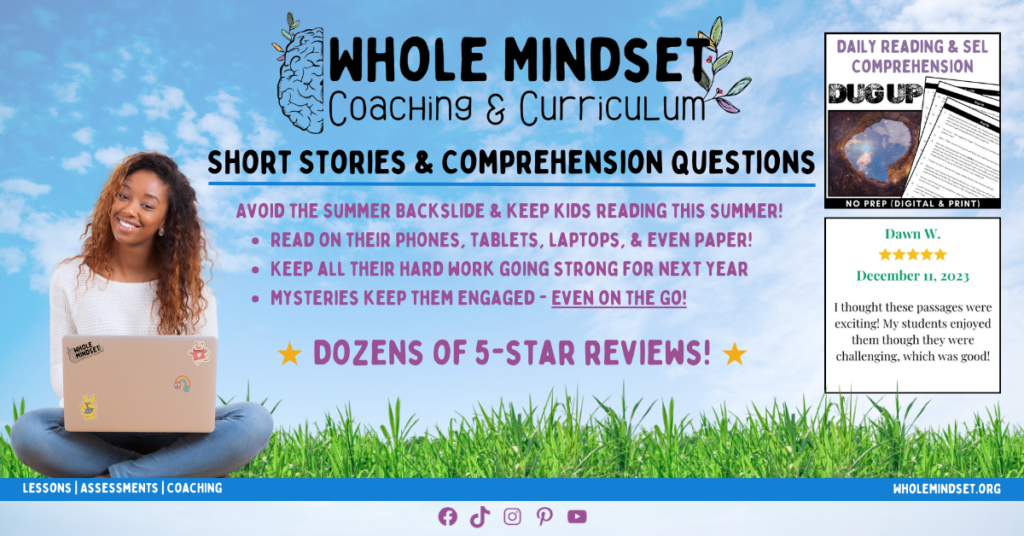Your cart is currently empty!
How to Create Stimulating Online Courses for Teens
I have wondered for years how an online course could ever be as effective as in-person learning. However, after completing teaching remotely, earning two different master’s degrees online, and working with all grade levels in a myriad of settings, I have concluded that online learning is actually an amazing opportunity for many students.
My daughter, for example, lives with some pretty intense anxiety at times. Without her core classes being online, I’m not sure how we would have survived the first two years of high school. Many of the students I’ve had in the past lacked the means to get to extracurricular activities like writing camps or tutoring opportunities, so online was their only option.
Access is not the only factor that makes online courses valuable assets. The majority of their value stems from their ability to create content that keeps the students engaged without a teacher hovering over them.
Keeping Students Engaged
Dartmouth Center for the Advancement of Learning hit the nail on the head when they explained that, “Designing a lecture to intentionally stimulate students’ thinking, rather than just deliver content, requires a student-centered focus. Research finds that student learning is enhanced by chunking lecture material into 5-15-minute segments, and interspersing with short, active learning exercises. These activities give students opportunities to engage with the material and to process it more deeply.” I couldn’t have said it any better.
As I develop various courses within the Whole Mindset curriculum, I look at ways to ensure students don’t get the chance (or have the desire) to just zone out. That means nuggets of information they can apply immediately.
Supporting Students
A stimulating lecture that is just the right amount of information is still not enough to ensure students are being reached. What I have found immensely helpful, with students as well as my own children, are examples. Not just any examples, but ones that resonate with them. As the Dartmouth excerpt stated, the content and approach need to be student-centered.
While I dearly love movies like Alfred Hitchcock’s Birds and Steven Spielberg’s Jaws, kids today likely have never seen them. So, as examples go, they aren’t great. But Indiana Jones or Star Wars? Excellent examples. If content isn’t relevant, kiss students’ attention spans goodbye.
Supporting an online course with relevant content that is delivered in nice-sized chunks is still not enough to ensure students absorb the information. I remember textbooks growing up… ick. With all of the tools and technology today, making schoolwork more visually grabbing is vital. After all, we have to compete for students’ attention when they have TikTok and YouTube going all the time.
Visuals are Key
Visually appealing material, that is presented in digestible amounts, with actionable information that is then internalized and used is the magic recipe for a stimulating online course for teens. Back when I was still teaching in a traditional classroom, I used this formula pretty much all the time. I lectured/taught for about 15 minutes (at the most) then I had students begin applying what was taught. Then, before class was over, we would re-group. Of course, during their work time, I walked through the room and worked with students who needed extra help.
I used to put a lot of effort into making sure there were visuals on the Smartboard, now with online course creation, the visuals are even more important because a teacher is not necessarily present to help explain things. Therefore, visuals should also appear in small chunks (typically alongside their corresponding text). This way, students are seeing, reading, and doing what is being instructed. They are engaged in an active learning process which actually alters how the brain receives the information.
Claire Hoogendoorn, Ph.D., wrote an article for CUNY in which she stated, “As more brain areas are activated, there are a higher number of cortical modules the hippocampi have to connect. This, in turn, makes memories more deeply embedded in the brain, and more easily retrievable.” The hippocampus is heavily involved in memory, learning, and emotion. When students are actively learning (group discussions, problem-solving, making connections…) then they are engaged in a way that stimulates the hippocampus and thus they connect with and retain the new information more deeply.
In the End…
We should never lose sight of the goal – helping students learn so they grow up with all of the skills and confidence they need to be successful.
Online courses can be an amazing opportunity for kids to learn material that isn’t covered in school, or that they want to learn more about. It can be an opportunity to dive into a topic they are passionate about. I know if the internet were a thing when I was a kid (wow I’m old…) I would have jumped at the chance to take a writing class over summer break. It just wasn’t an option back then, but kids today are very lucky to have endless growth opportunities, regardless of their ages, locations, or otherwise.
Whole Mindset is developing a number of online courses, both for teens and adults. Enrollment will be limited, so join the newsletter to be the first to know when enrollment opens.



